Authors: Sato, Koh | Ohtomo, Toshihiko | Hirata, Yuichi | Saito, Hiroyuki | Matsuura, Tetsu | Akimoto, Toshio | Akamatsu, Ken-ichi | Koishihara, Yasuo | Ohsugi, Yoshiyuki | Tsuchiya, Masayuki
Article Type:
Research Article
Abstract:
Interleukin-6 (IL-6) inhibitors are good potential therapeutic agents in human patients, and anti-IL-6 antibodies are among the best candidates. Here, we have successfully humanized mouse monoclonal antibody SK2, which specifically binds to IL-6 and strongly inhibits IL-6 functions. Since this antibody possesses N-linked carbohydrates on Asn-30 of VH region, which seems to be very close to an antigen-binding site, influence of these carbohydrates on antigen-binding was investigated. A biosensor study showed that the mouse SK2 Fab and its deglycosylated fragments had almost equal Kd (Kon /Koff ), 26.8 nM (1.05×106 12.81×10−2 ) and 24.7 nM (1.28×106 13.15×10−2 ), respectively.
…Furthermore, a mutant chimeric SK2 antibody, in which the N-glycosylation site was removed from the VH region, showed a Kd of 11 nM, almost similar to that of the original chimeric SK2 antibody, determined by Scatchard analysis with 125 I-IL-6. These data indicate the carbohydrates of mouse SK2 VH region do not significantly influence antigen-binding activity. In the next step, two versions of each humanized SK2 VL and VH regions were carefully designed based on the amino acid sequences of human REI and DAW, respectively. Only one alteration, Tyr to Phe, was made at position 71 in the two light chains, according to the canonical residue for L1. A N-glycosylation site was introduced on the two heavy chains, by changing Ser to Asn at position 30. All four combinations of humanized light and heavy chains could bind to IL-6 as well as the chimeric SK2 antibody. The light chain first version, however, could not efficiently inhibit IL-6 binding to its receptor, indicating the importance of the L1 loop conformation for the inhibitory activity of SK2 antibody. In contrast, both versions of the heavy chains were comparable, in yielding good humanized SK2 antibodies, suggesting that the glycosylation of the SK2 VH region has no influence in recreating a functional antigen-binding site in this humanization.
Show more
Keywords: Humanization, monoclonal antibody, IL-6, glycosylation
DOI: 10.3233/HAB-1996-7405
Citation: Human Antibodies,
vol. 7, no. 4, pp. 175-183, 1996
Price: EUR 27.50





